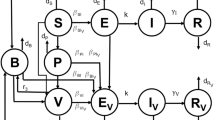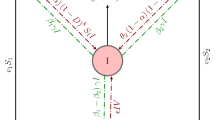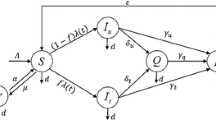Abstract
Several safe and effective vaccines are available to prevent individuals from experiencing severe illness or death as a result of COVID-19. Widespread vaccination is widely regarded as a critical tool in the fight against the disease. However, some individuals may choose not to vaccinate due to vaccine hesitancy or other medical conditions. In some sectors, regular compulsory testing is required for such unvaccinated individuals. Interestingly, different sectors require testing at various frequencies, such as weekly or biweekly. As a result, it is essential to determine the optimal testing frequency and identify underlying factors. This study proposes a population-based model that can accommodate different personal decision choices, such as getting vaccinated or undergoing regular tests, as well as vaccine efficacies and uncertainties in epidemic transmission. The model, formulated as impulsive differential equations, uses time instants to represent the reporting date for the test result of an unvaccinated individual. By employing well-accepted indices to measure transmission risk, including the basic reproduction number, the peak time, the final size, and the number of severe infections, the study shows that an optimal testing frequency is highly sensitive to parameters involved in the transmission process, such as vaccine efficacy, disease transmission rate, test accuracy, and existing vaccination coverage. The testing frequency should be appropriately designed with the consideration of all these factors, as well as the control objectives measured by epidemiological quantities of great concern.













Similar content being viewed by others
References
Bai Z, Zhao X-Q (2020) Basic reproduction ratios for periodic and time-delayed compartmental models with impulses. J Math Biol 80:1095–1117
Böttcher L, D’Orsogna MR, Chou T (2021) A statistical model of COVID-19 testing in populations: effects of sampling bias and testing errors. Phil Trans R Soc A 380:20210121
Boyarsky BJ, Werbel WA, Avery RK et al (2021) Antibody response to 2-dose SARS-CoV-2 mRNA vaccine series in solid organ transplant recipients. JAMA 325:2204–2206
Brauer F (2008) Compartmental models in epidemiology. In: Mathematical epidemiology, pp 19–79
Brook CE, Northrup GR, Ehrenberg AJ et al (2021) Optimizing COVID-19 control with asymptomatic surveillance testing in a university environment. Epidemics 37:100527
Centers for Diseasse Control and Prevention, US. https://www.cdc.gov/coronavirus/2019-ncov/symptoms-testing/testing.html. Accessed Nov 2021
Clark University, Healthy Clark COVID Plan. https://www.clarku.edu/healthy-clark-covid-plan/vaccinations/. Accessed Nov 2021
Cui J, Zhang Y, Feng Z (2019) Influence of non-homogeneous mixing on final epidemic size in a meta-population model. J Biol Dyn 13:31–46
Diekmann O, Heesterbeek J, Metz JA (1990) On the definition and the computation of the basic reproduction ratio \(R_0\) in models for infectious diseases in heterogeneous populations. J Math Biol 28:365–382
Du Z, Pandey A, Bai Y et al (2021) Comparative cost-effectiveness of SARS-CoV-2 testing strategies in the USA: a modelling study, Lancet. Public Health 6:e184–e191
Evans S, Agnew E, Vynnycky E, Robotham JV (2021) The impact of testing and infection prevention and control strategies on within-hospital transmission dynamics of COVID-19 in English hospitals. Philos Trans R Soc Lond B Biol Sci 376:20200268
Federal Register, Emergency Temporary Standard. https://www.federalregister.gov/documents/2021/11/05/2021-23643/covid-19-vaccination-and-testing-emergency-temporary-standard. Accessed Nov 2021
Ferretti L, Wymant C, Kendall M et al (2020) Quantifying SARS-CoV-2 transmission suggests epidemic control with digital contact tracing. Science 368:eabb6936
Forde JE, Ciupe SM (2021) Quantification of the tradeoff between test sensitivity and test frequency in a COVID-19 epidemic—a multi-scale modeling approach. Viruses 13:457
Global News, BC universities COVID-19 plan. https://globalnews.ca/news/8145022/sfu-vaccine-disclosure/. Accessed Nov 2021
Government of Canada, Framework on mandatory COVID-19 testing for implementation of the policy on COVID-19 vaccination for the core public administration including the Royal Canadian Mounted Police. https://www.canada.ca/en/government/publicservice/covid-19/vaccination-public-service/framework-mandatory-covid-19-testing-implementation-policy-covid-19-vaccination-cpa-including-rcmp.html. Accessed Nov 2021
Grassly NC, Pons-Salort M, Parker EPK et al (2020) Comparison of molecular testing strategies for COVID-19 control: a mathematical modelling study. Lancet Infect Dis 20:1381–1389
Haleem A, Javaid M, Vaishya R (2020) Effects of COVID-19 pandemic in daily life. Curr Med Res Pract 10:78
Herrera-Esposito D, de Los Campos G (2022) Age-specific rate of severe and critical SARS-CoV-2 infections estimated with multi-country seroprevalence studies. BMC Infect Dis 22:311
Hu S, Wang W, Wang Y et al (2021) Infectivity, susceptibility, and risk factors associated with SARS-CoV-2 transmission under intensive contact tracing in Hunan, China. Nat Commun 12:1–11
Kucharski AJ, Klepac P, Conlan AJK et al (2020) Effectiveness of isolation, testing, contact tracing, and physical distancing on reducing transmission of SARS-CoV-2 in different settings: a mathematical modelling study. Lancet Infect Dis 10:1151–1160
La Marca A, Capuzzo M, Paglia T et al (2020) Testing for SARS-CoV-2 (COVID-19): a systematic review and clinical guide to molecular and serological in-vitro diagnostic assays. Reprod Biomed Online 41:483–499
Larremore DB, Wilder B, Lester E et al (2021) Test sensitivity is secondary to frequency and turnaround time for COVID-19 screening. Sci Adv 7:eabd5393
Liang X, Zhang L, Zhao X-Q (2019) Basic reproduction ratios for periodic abstract functional differential equations (with application to a spatial model for Lyme disease). J Dyn Differ Equ 31:1247–1278
Magal P, Seydi O, Webb G (2016) Final size of an epidemic for a two-group SIR model. SIAM J Appl Math 76:2042–2059
Marcelin JR, Pettifor A, Janes H, Brown ER et al (2022) COVID-19 Vaccines and SARS-CoV-2 transmission in the era of new variants: a review and perspective. Open Forum Infect Dis 9:ofac124
Mina MJ, Parker R, Larremore DB (2020) Rethinking COVID-19 test sensitivity-a strategy for containment. N Engl J Med 383:e120
MSN, US require COVID-19 vaccinations or regular testing for federal workers. https://www.msn.com/en-us/news/politics/biden-expected-to-push-vaccine-for-federal-workers/ar-AAMGJc0. Accessed Nov 2021
National Health Service, Regular rapid lateral flow coronavirus (COVID-19) tests. https://www.nhs.uk/conditions/coronavirus-covid-19/testing/regular-rapid-coronavirus-tests-if-you-do-not-have-symptoms/. Accessed Nov 2021
Néant N, Lingas G, Le Hingrat Q et al (2021) Modeling SARS-CoV-2 viral kinetics and association with mortality in hospitalized patients from the French COVID cohort. PNAS 118:e2017962118
Pharmaceutical Technology, Covid-19 Vaccination Tracker, Coronavirus vaccine roll out statistics by country. https://www.pharmaceutical-technology.com/covid-19-vaccination-tracker/. Accessed Nov 2021
Pouwels KB, Pritchard E, Matthews PC, Stoesser N et al (2021) Effect of Delta variant on viral burden and vaccine effectiveness against new SARS-CoV-2 infections in the UK. Nat Med 27:2127–2135
Rădulescu A, Williams C, Cavanagh K (2020) Management strategies in a SEIR-type model of COVID 19 community spread. Sci Rep 10:1–16
Reuters, Countries making COVID-19 vaccines mandatory. https://news.trust.org/item/20210804140458-ari9l. Accessed Nov 2021
Salvatore PP, Shah MM, Ford L et al (2022) Quantitative comparison of SARS-CoV-2 nucleic acid amplification test and antigen testing algorithms: a decision analysis simulation model. BMC Public Health 22:82
Scientific Committee on Vaccine Preventable Diseases, The Government of the Hong Kong Special Administrative Region, Interim Guidance Notes On Common Medical Diseases and COVID-19 Vaccination In Primary Care Settings, As of September 3, 2021
Stanford University, Stanford COVID-19 Health Alerts. https://healthalerts.stanford.edu/covid-19/. Accessed Nov 2021
The Chinese University of Hong Kong. https://www.oal.cuhk.edu.hk/covid-19-incoming/. Accessed 13 Sept 2021
The Education University of Hong Kong. https://eduhk.hk/sao/info/student_halls/news_and_event/. Accessed 13 Sept 2021
The Government of the Hong Kong Special Administrative Region. https://www.news.gov.hk/eng/2021/08/20210802/20210802_182826_426.html. Accessed 13 Sept 2021
The Hong Kong Baptist University. https://webcache.googleusercontent.com/search?q=cache:_WOSvMWIczUJ:https://ehsu.hkbu.edu.hk/2019-nCOV/20210825. Accessed 13 Sept 2021
The Hong Kong Polytechnic University. https://www.polyu.edu.hk/ar/web/en/for-polyu-students/notices-to-students/index.html?id=313. Accessed 13 Sept 2021
The Hong Kong University of Science and Technology. https://covid19info.ust.hk/covid-19-vaccination-or-regular-testing-requirement. Accessed 13 Sept 2021
The Hong Kong University. https://www.cedars.hku.hk/index.php?route=event/event &event_id=100763. Accessed 13 Sept 13 2021
The Singapore government, Vaccination or Regular testing. https://www.mom.gov.sg/covid-19/advisory-on-vort-for-frontline-workers. Accessed Nov 2021
Thompson MG, Burgess JL, Naleway AL et al (2021) Prevention and attenuation of COVID-19 with the BNT162b2 and mRNA-1273 vaccines. N Engl J Med 385:320–329
University of California, Davis, UC Davis COVID-19 testing. https://campusready.ucdavis.edu/testing-response/covid19-screening. Accessed Nov 2021
University of Kent, Regular testing for COVID-19 in University of Kent. https://blogs.kent.ac.uk/staff-student-news/2021/01/22/regular-testing-for-covid-19/. Accessed Nov 2021
University of Oxford, Regular testing for COVID-19 in University of Oxford. https://www.ox.ac.uk/coronavirus/health/covid-testing. Accessed Nov 2021
University of Stirling. https://www.stir.ac.uk/coronavirus/updates/title-127013-en.html. Accessed Nov 2021
van den Driessche P, Watmough J (2002) Reproduction numbers and sub-threshold endemic equilibria for compartmental models of disease transmission. Math Biosci 180:29–48
Variety, US local governments require COVID-19 vaccinations or regular testing for city employees. https://variety.com/2021/politics/news/los-angeles-require-vaccines-covid-tests-city-employees-1235028939/#!. Accessed Nov 2021
Wallace BI, Kenney B, Malani PN et al (2021) Prevalence of immunosuppressive drug use among commercially insured US adults, 2018–2019. JAMA Netw Open 4:e214920
Wells CR, Townsend JP, Pandey A et al (2021) Optimal COVID-19 quarantine and testing strategies. Nat Commun 12:1–9
World Health Organization (2021) Transmission of SARS-CoV-2: implications for infection prevention precautions: scientific brief
World Health Organization, WHO Director-General’s opening remarks at the media briefing on COVID-19. Accessed 11 Mar 2020
Yu B, Li Q, Chen J, He D (2023) The impact of COVID-19 vaccination campaign in Hong Kong SAR China and Singapore. Infect Dis Model 8:101–106
Zhang Y, Cheng SR (2020) Evaluating the need for routine COVID-19 testing of emergency department staff: quantitative analysis. JMIR Public Health Surveill 6:e20260
Acknowledgements
K. Liu was supported by the National Natural Science Foundation of China [Grant No. 11901247], Foundation for High-Level Entrepreneurial and Innovative Talents of Jiangsu Province, and Research Grants for High-Level Talents of Jiangsu University. Z. Bai’s research was supported by the NSF of China [11971369]. Y. Lou’s research was partially supported by the NSF of China [12071393], The Hong Kong Research Grants Council [15304821, C5079-21GF]. The authors would like to extend our sincere gratitude to two anonymous referees for providing valuable and constructive comments that greatly enhanced the quality of the original manuscript.
Author information
Authors and Affiliations
Corresponding author
Ethics declarations
Conflict of interest
The authors declare that they have no known competing financial interests or personal relationships that could have appeared to influence the work reported in this paper.
Additional information
Publisher's Note
Springer Nature remains neutral with regard to jurisdictional claims in published maps and institutional affiliations.
Rights and permissions
Springer Nature or its licensor (e.g. a society or other partner) holds exclusive rights to this article under a publishing agreement with the author(s) or other rightsholder(s); author self-archiving of the accepted manuscript version of this article is solely governed by the terms of such publishing agreement and applicable law.
About this article
Cite this article
Liu, K., Bai, Z., He, D. et al. Getting Jab or Regular Test: Observations from an Impulsive Epidemic COVID-19 Model. Bull Math Biol 85, 97 (2023). https://doi.org/10.1007/s11538-023-01202-y
Received:
Accepted:
Published:
DOI: https://doi.org/10.1007/s11538-023-01202-y




